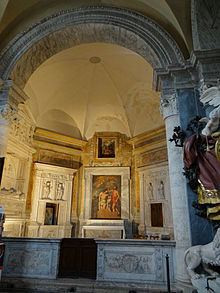 | ||
The Montemirabile or Saint John the Baptist Chapel, otherwise the Baptistery (Italian: Cappella Montemirabile, Cappella di San Giovanni Battista, Cappella del battistero) is the first side chapel in the left aisle in Basilica of Santa Maria del Popolo. The chapel was transformed to the baptistery of the basilica in 1561.
Contents
History
The chapel was built by Giovanni Montemirabile (an italianized name for Jean de Montmirail), the bishop of Vaison and a confidant of Pope Sixtus IV who rebuilt the basilica at the same time. It was dedicated to St. John the Baptist. The funeral chapel was transformed into a baptistery in 1561. The basic architectural layout is similar to the other 15th century side chapels of the basilica but many of its features were lost during the later alterations. In the mid-seventeenth century the quattrocento sculptural works were restructured. In the 17th century a new painting was made for the main altar by Pasquale Rossi.
Description
The side walls of the hexagonal chapel are articulated by painted Corinthian pilasters decorated with candelabra, flowers and garlands on a yellow background, resting on a fake monochrome pedestal. The vault is now simply painted white. The original marble slabs of the parapet with the della Rovere coat-of-arms are probably the most finely elaborated in the basilica. They are similar to the parapet slabs of the Della Rovere Chapel but the coats are framed with wreathes and the dwarf pilasters are decorated with different types of shields and garlands of fruit.
The most valuable works of art in the chapel are the edicules of the baptismal font and the holy oil on either side of the main altar. The 15th century marbles are exquisite sculptural works by the school of Andrea Bregno. In the middle of the 17th century they were re-assembled and their original elements were integrated with new additions. The marbles originate from the old main altar which was demolished (other fragments are kept in the sacristy).
The funeral monument of Cardinal Antoniotto Pallavicini on the left wall was made by the Bregno workshop. It was originally in the Old St. Peter's Basilica where a Dutch traveller, Aernout van Buchel saw in 1587 among various other discarded tombs and sculptures in the nave due to the building works. The monument was transferred to the Basilica of Santa Maria del Popolo in 1596 to which date the inscription on the base belongs. An earlier inscription on the sarcophagus declares that "always having death in mind, Antoniotto Cardinal of S. Prassede, erected [this tomb monument] for himself while still alive, in the year 1501". It has been placed in the first chapel of the left aisle in 1630. This is an elaborate funeral monument in the form of an aedicule with two finely carved Corinthian pilasters holding a heavy entablature. The marble sarcophagus with the reclining statue of the dead cardinal is placed in a large rectangular niche forming an open tomb. On the back wall of the niche there is a relief set in a lunette depicting the Madonna with the Child flanked by two angels in adoration. The whole sepulchre is crowned by a pedimented gable with the relief of God, the father in the glory of Heaven.
The other tomb on the right wall is of Cardinal Francesco Abbondio Castiglioni who died in 1568. The veined marble sarcophagus is placed on a high base which is decorated with the coats-of-arms of the Cardinal. The marble wall is flanked by Corinthian pilasters and crowned with a heavily articulated cornice and pediment. The realistic portrait bust of the deceised is set in an oval niche and a Latin inscription says: EXPECTO DONEC VENIAT IMMUTATIO MEA (I wait until my change comes).
The tomb slab of the founder of the chapel, Giovanni Montemirabile is built in the floor. "The well-shaped, intellectual, but slightly cynical, face has suffered little injury from time." The slab is framed by a wide band of swirling oak branches, a symbol of the Della Rovere family. The Latin inscription makes another reference to the Pope: "Ioannem de Montemirabili hic sepultum, intelligentia apostolicum abbreviatorem, fides referendarium secretum, probitas Sixto IV. Pontefici Maximo familiarem, religio episcopum Vasionensem fecit, quibus perfunctus septuagenarius obiit 4 Junii 1479. Haec, si consideres, satis admonent." (Ioannes de Montemirabilia is buried here, intelligence made him abbreviator apostolic, faith secret referendary, probity the familiar of Pope Sixtus IV., religion the Bishop of Vaison, died as a septuagenarian on 4 June 1479. These, if you consider, admonish sufficiently.)
The Baptism of Christ on the altar was painted by Pasquale Rossi and was first mentioned in the sources in 1674. It is one of the few public works of the Vicentine painter in Rome. The same subject was depicted on an older altarpiece (now lost). The lower part of the painting is seriously damaged. The biblical scene is set in a dark, lyrical landscape with dense clouds and the figure of God and angels on the sky. On this painting "De Rossi demonstrates a stylistic maturity in the field of ecclesiastical and devotional painting, a field sometimes neglected by the critics", states Ilaria Miarelli Mariani. The painting is set in a simple stone frame. Above there is a small fresco of the Madonna with the Child in a rectangular niche.
